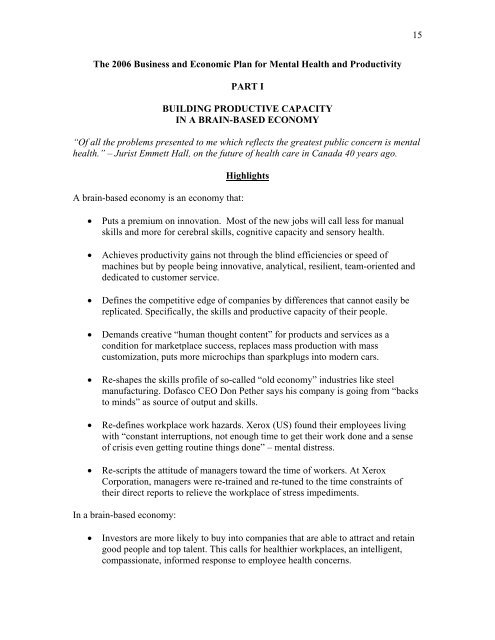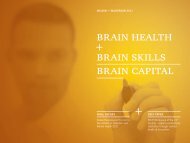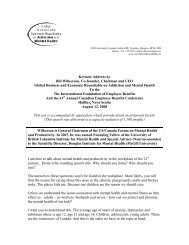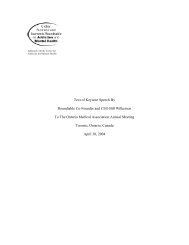PART I - Global Business and Economic Roundtable on Addiction ...
PART I - Global Business and Economic Roundtable on Addiction ...
PART I - Global Business and Economic Roundtable on Addiction ...
Create successful ePaper yourself
Turn your PDF publications into a flip-book with our unique Google optimized e-Paper software.
15<br />
The 2006 <str<strong>on</strong>g>Business</str<strong>on</strong>g> <str<strong>on</strong>g>and</str<strong>on</strong>g> <str<strong>on</strong>g>Ec<strong>on</strong>omic</str<strong>on</strong>g> Plan for Mental Health <str<strong>on</strong>g>and</str<strong>on</strong>g> Productivity<br />
<str<strong>on</strong>g>PART</str<strong>on</strong>g> I<br />
BUILDING PRODUCTIVE CAPACITY<br />
IN A BRAIN-BASED ECONOMY<br />
“Of all the problems presented to me which reflects the greatest public c<strong>on</strong>cern is mental<br />
health.” – Jurist Emmett Hall, <strong>on</strong> the future of health care in Canada 40 years ago.<br />
A brain-based ec<strong>on</strong>omy is an ec<strong>on</strong>omy that:<br />
Highlights<br />
• Puts a premium <strong>on</strong> innovati<strong>on</strong>. Most of the new jobs will call less for manual<br />
skills <str<strong>on</strong>g>and</str<strong>on</strong>g> more for cerebral skills, cognitive capacity <str<strong>on</strong>g>and</str<strong>on</strong>g> sensory health.<br />
• Achieves productivity gains not through the blind efficiencies or speed of<br />
machines but by people being innovative, analytical, resilient, team-oriented <str<strong>on</strong>g>and</str<strong>on</strong>g><br />
dedicated to customer service.<br />
• Defines the competitive edge of companies by differences that cannot easily be<br />
replicated. Specifically, the skills <str<strong>on</strong>g>and</str<strong>on</strong>g> productive capacity of their people.<br />
• Dem<str<strong>on</strong>g>and</str<strong>on</strong>g>s creative “human thought c<strong>on</strong>tent” for products <str<strong>on</strong>g>and</str<strong>on</strong>g> services as a<br />
c<strong>on</strong>diti<strong>on</strong> for marketplace success, replaces mass producti<strong>on</strong> with mass<br />
customizati<strong>on</strong>, puts more microchips than sparkplugs into modern cars.<br />
• Re-shapes the skills profile of so-called “old ec<strong>on</strong>omy” industries like steel<br />
manufacturing. Dofasco CEO D<strong>on</strong> Pether says his company is going from “backs<br />
to minds” as source of output <str<strong>on</strong>g>and</str<strong>on</strong>g> skills.<br />
• Re-defines workplace work hazards. Xerox (US) found their employees living<br />
with “c<strong>on</strong>stant interrupti<strong>on</strong>s, not enough time to get their work d<strong>on</strong>e <str<strong>on</strong>g>and</str<strong>on</strong>g> a sense<br />
of crisis even getting routine things d<strong>on</strong>e” – mental distress.<br />
• Re-scripts the attitude of managers toward the time of workers. At Xerox<br />
Corporati<strong>on</strong>, managers were re-trained <str<strong>on</strong>g>and</str<strong>on</strong>g> re-tuned to the time c<strong>on</strong>straints of<br />
their direct reports to relieve the workplace of stress impediments.<br />
In a brain-based ec<strong>on</strong>omy:<br />
• Investors are more likely to buy into companies that are able to attract <str<strong>on</strong>g>and</str<strong>on</strong>g> retain<br />
good people <str<strong>on</strong>g>and</str<strong>on</strong>g> top talent. This calls for healthier workplaces, an intelligent,<br />
compassi<strong>on</strong>ate, informed resp<strong>on</strong>se to employee health c<strong>on</strong>cerns.
16<br />
• The surest way to profits is treating employees as assets, the premise for this<br />
Plan’s c<strong>on</strong>cept of “human capitalizati<strong>on</strong>.”<br />
• There are measurable returns <strong>on</strong> investments in occupati<strong>on</strong>al health services for<br />
employees with mental distress <str<strong>on</strong>g>and</str<strong>on</strong>g> disorders <str<strong>on</strong>g>and</str<strong>on</strong>g> testim<strong>on</strong>y from several Fortune<br />
500 companies named in this Plan says why:<br />
1. Employee attitudes <str<strong>on</strong>g>and</str<strong>on</strong>g> well-being are linked to financial results.<br />
2. Re-shaping corporate culture is as important as m<strong>on</strong>itoring $ results.<br />
3. Best-run firms promote emoti<strong>on</strong>al ties <str<strong>on</strong>g>and</str<strong>on</strong>g> well-being.<br />
4. Compelling place to invest is a compelling place to work.<br />
5. Employees who feel they count predict financial results.<br />
• The building blocks of productive capacity in a brain-based ec<strong>on</strong>omy are not the<br />
building blocks of factories <str<strong>on</strong>g>and</str<strong>on</strong>g> offices. They are different <str<strong>on</strong>g>and</str<strong>on</strong>g> specific.<br />
The Wils<strong>on</strong> Principle<br />
H<strong>on</strong>ourable Michael Wils<strong>on</strong>, <str<strong>on</strong>g>Roundtable</str<strong>on</strong>g> Senior Chairman articulates the core principle<br />
of this <str<strong>on</strong>g>Business</str<strong>on</strong>g> <str<strong>on</strong>g>and</str<strong>on</strong>g> <str<strong>on</strong>g>Ec<strong>on</strong>omic</str<strong>on</strong>g> Plan for Mental Health <str<strong>on</strong>g>and</str<strong>on</strong>g> Productivity.<br />
“We have seen tremendous progress in preventing physical injuries <str<strong>on</strong>g>and</str<strong>on</strong>g> illnesses at<br />
work. The safety records of companies I am associated with are a source of great pride to<br />
them.<br />
“It would be a shame to un-do 30 years of great progress in physical health <str<strong>on</strong>g>and</str<strong>on</strong>g> safety as<br />
a result of massive losses of productive capacity due to untreated mental illness in the<br />
workplace.”<br />
British Petroleum Health Savings<br />
At British Petroleum, efforts are underway to twin employee health with well-established<br />
plant safety. The Wils<strong>on</strong> Principle in acti<strong>on</strong>. BP’s vice-president for health, Dr. Chris<br />
Roythorne, says why:<br />
“At the company’s Texas plant, proactive case management programs encouraged<br />
employees to seek medical attenti<strong>on</strong> when they needed it. The result: $5 milli<strong>on</strong> in savings<br />
due to reduced absenteeism.”<br />
Dr. Roythorne says in a media interview that the company may “be losing $14,000 per<br />
employee per year in health-related productivity losses <str<strong>on</strong>g>and</str<strong>on</strong>g> if you reduced that by even<br />
$1,000 per year, the company would save $10 milli<strong>on</strong> per year.”
17<br />
MINDSETS: Mental Health – The Ultimate Productivity Weap<strong>on</strong> (1998)<br />
<str<strong>on</strong>g>Roundtable</str<strong>on</strong>g> CEO Bill Wilkers<strong>on</strong> <str<strong>on</strong>g>and</str<strong>on</strong>g> Dr. Edgardo Perez, CEO <str<strong>on</strong>g>and</str<strong>on</strong>g> Chief of Staff of the<br />
Homewood Health Centre, co-authored the first comprehensive examinati<strong>on</strong> of the<br />
business <str<strong>on</strong>g>and</str<strong>on</strong>g> ec<strong>on</strong>omic effects of mental health in a 350-page book lauded by the<br />
American Psychiatric Associati<strong>on</strong> <str<strong>on</strong>g>and</str<strong>on</strong>g> World Federati<strong>on</strong> for Mental Health.<br />
This set the stage for the <str<strong>on</strong>g>Roundtable</str<strong>on</strong>g>’s start-up <str<strong>on</strong>g>and</str<strong>on</strong>g> the advent of mental health in the<br />
workplace as a Canadian ec<strong>on</strong>omic, health <str<strong>on</strong>g>and</str<strong>on</strong>g> social issue.<br />
<str<strong>on</strong>g>Business</str<strong>on</strong>g> Plan to Defeat Depressi<strong>on</strong> – 2000<br />
On the heels of MINDSETS, the <str<strong>on</strong>g>Roundtable</str<strong>on</strong>g> introduced a business plan focused <strong>on</strong> the<br />
medical <str<strong>on</strong>g>and</str<strong>on</strong>g> n<strong>on</strong>-medical aspects of fighting depressi<strong>on</strong> in the workforce.<br />
Released in news c<strong>on</strong>ferences in Tor<strong>on</strong>to, Canada <str<strong>on</strong>g>and</str<strong>on</strong>g> Geneva, Switzerl<str<strong>on</strong>g>and</str<strong>on</strong>g>, this 12-point<br />
initiative attracted substantial interest from many parts of the world which c<strong>on</strong>tinues<br />
today.<br />
Three themes characterized the 2000 plan <str<strong>on</strong>g>and</str<strong>on</strong>g> remain relevant today:<br />
• One, the importance of CEO leadership in reducing the costs <str<strong>on</strong>g>and</str<strong>on</strong>g> effects of mental<br />
disorders in the workplace.<br />
• Two, the necessity of hard financial targets to stimulate acti<strong>on</strong>. Health related<br />
costs – as a percentage of pay roll – is <strong>on</strong>e indicator.<br />
• Three, the need to modify <str<strong>on</strong>g>and</str<strong>on</strong>g>, if necessary, re-vamp workplace practices which<br />
are known to create envir<strong>on</strong>ments where employee health is compromised.<br />
We proposed in 2000 – <str<strong>on</strong>g>and</str<strong>on</strong>g> repeat now – steps to relieve employees of the pressures<br />
driven by an email-<strong>on</strong>ly culture of communicati<strong>on</strong>s. Employers are awakening to this.<br />
“Mindsets Grow <str<strong>on</strong>g>Business</str<strong>on</strong>g>es”<br />
Roger Enrico, former CEO, Pepsico<br />
The 2006 <str<strong>on</strong>g>Business</str<strong>on</strong>g> <str<strong>on</strong>g>and</str<strong>on</strong>g> <str<strong>on</strong>g>Ec<strong>on</strong>omic</str<strong>on</strong>g> Plan link mental health <str<strong>on</strong>g>and</str<strong>on</strong>g> productivity in workplaces<br />
of a brain-based ec<strong>on</strong>omy. This discourse follows next.<br />
For 12-15 years (at least), we have been witness to mass downsizings in ec<strong>on</strong>omies<br />
around the world. Michael Wils<strong>on</strong> says “mass lay-offs have become the first not last<br />
alternative to h<str<strong>on</strong>g>and</str<strong>on</strong>g>le downturns.”<br />
In Canada, as productivity lagged the number of hours that employees worked, even<br />
profitable companies cut jobs to dance the haunting rhythm of shareholder value. We<br />
entered an investor-driven ec<strong>on</strong>omy.
18<br />
It appears, however, that downsizings <strong>on</strong> a large scale proved to be more fool’s gold than<br />
m<strong>on</strong>ey in the bank – to wit:<br />
• The compound annual growth rate in the market value of companies that achieved<br />
higher than average (bottom-line) growth but lower revenue growth compared to<br />
their industry average was half that of competitors who had both higher profits<br />
<str<strong>on</strong>g>and</str<strong>on</strong>g> higher revenues. (William Mercer <str<strong>on</strong>g>and</str<strong>on</strong>g> Company)<br />
This suggests top-to-bottom line growth is healthier for shareholders than cuts-to-bottomline<br />
growth.<br />
Fortune Magazine: “Without doubt it is easier to get a dollar of profit by cutting costs<br />
than by raising revenues. But investors, the final arbiters of value, know that these two<br />
dollars are very unlike in terms of the future they presage.”<br />
A survey by the American Management Associati<strong>on</strong> finds that fewer than half of the<br />
companies that downsized since 1990 – fewer than half – went <strong>on</strong> to report higher<br />
operating profits in the years following the lay-off’s <str<strong>on</strong>g>and</str<strong>on</strong>g> even fewer saw improved<br />
productivity.<br />
Research by the U.S. c<strong>on</strong>sulting firm, M<strong>on</strong>itor, found that nine out of ten firms that outperformed<br />
their industry over a 10-year period had stable structures with no more than<br />
<strong>on</strong>e reorganizati<strong>on</strong> <str<strong>on</strong>g>and</str<strong>on</strong>g> no change in the CEO.<br />
Human Indicators of Corporate Success<br />
The milest<strong>on</strong>e study by Sears Roebuck says this: “A compelling place to work is a<br />
compelling place to shop <str<strong>on</strong>g>and</str<strong>on</strong>g> a compelling place to invest.” The study links employee<br />
attitudes to customer satisfacti<strong>on</strong> <str<strong>on</strong>g>and</str<strong>on</strong>g> ultimately financial results.<br />
It shows, in fact, that a five point improvement in employee satisfacti<strong>on</strong> drives a 1.3%<br />
improvement in customer satisfacti<strong>on</strong> <str<strong>on</strong>g>and</str<strong>on</strong>g> nearly .05% in revenue growth. Metrics<br />
finally catch up to comm<strong>on</strong> sense.<br />
PricewaterhouseCoopers in the U.S. <str<strong>on</strong>g>and</str<strong>on</strong>g> Europe reports that CEOs now spend as much or<br />
more time <strong>on</strong> “people issues” as financial matters. Half say re-shaping culture <str<strong>on</strong>g>and</str<strong>on</strong>g><br />
employee behaviour both rank with setting <str<strong>on</strong>g>and</str<strong>on</strong>g> m<strong>on</strong>itoring financial results.<br />
The best-run firms put an emphasis <strong>on</strong> best practices which promote emoti<strong>on</strong>al ties <str<strong>on</strong>g>and</str<strong>on</strong>g><br />
well-being. As a result, over 10 years, investing $1,000 in the Fortune 100 Best Run<br />
Companies produced a return of $8,000, twice that of companies not <strong>on</strong> the list.<br />
The Gallup organizati<strong>on</strong> surveyed 55,000 workers to match attitudes <str<strong>on</strong>g>and</str<strong>on</strong>g> financial results<br />
<str<strong>on</strong>g>and</str<strong>on</strong>g> found that four attitudes in particular that, taken together, str<strong>on</strong>gly correlate with<br />
higher profits – employees:
19<br />
1. Feeling they are being given an opportunity to do their best every day.<br />
2. Believing their opini<strong>on</strong>s count.<br />
3. Sensing their company is committed to quality.<br />
4. Seeing a direct c<strong>on</strong>necti<strong>on</strong> between their efforts <str<strong>on</strong>g>and</str<strong>on</strong>g> the company’s missi<strong>on</strong>.<br />
C<strong>on</strong>sulting giant Ernst <str<strong>on</strong>g>and</str<strong>on</strong>g> Young says investors are now more likely to buy stock based<br />
<strong>on</strong> a company’s ability to attract <str<strong>on</strong>g>and</str<strong>on</strong>g> keep talented people. CEOs in a <str<strong>on</strong>g>Roundtable</str<strong>on</strong>g> survey<br />
said promoting mental health is an attribute that will attract good people.<br />
According to a study for the U.S. Commerce Department by the Whart<strong>on</strong> School <str<strong>on</strong>g>and</str<strong>on</strong>g><br />
Harvard <str<strong>on</strong>g>Business</str<strong>on</strong>g> School, “a company’s surest way to profits is to treat their employees<br />
as assets.”<br />
Based <strong>on</strong> its global experience, General Electric – <strong>on</strong>e of the toughest <str<strong>on</strong>g>and</str<strong>on</strong>g> most<br />
competitive corporati<strong>on</strong>s in the world – affirms that it has seen a positive return <strong>on</strong> its<br />
investment in occupati<strong>on</strong>al health services for its employees worldwide.<br />
Other major corporati<strong>on</strong>s with household names report their findings:<br />
3M Company – with 74,000 employs – introduced a human capital measurement tool that<br />
integrates employee health <str<strong>on</strong>g>and</str<strong>on</strong>g> productivity; the company used this tool to drive down<br />
abuse of prescripti<strong>on</strong> drugs, adverse work climates, troubled workplace relati<strong>on</strong>ships <str<strong>on</strong>g>and</str<strong>on</strong>g><br />
management practices that undermine the emoti<strong>on</strong>al state of employees.<br />
Pepsico employed a balanced scorecard which focused <strong>on</strong> four specific measures:<br />
employee enthusiasm, financial performance, customer experience <str<strong>on</strong>g>and</str<strong>on</strong>g> c<strong>on</strong>sumer<br />
percepti<strong>on</strong>s of the company. Pepsico’s former CEO Roger Enrico said “mindsets grow<br />
businesses.”<br />
Studies by Johns<strong>on</strong>&Johns<strong>on</strong>, Chase Manhatten Bank, Motorola, Marriott Hotels<br />
<str<strong>on</strong>g>and</str<strong>on</strong>g> Merck Corporati<strong>on</strong> says employers that help employees resolve time c<strong>on</strong>flicts<br />
attract more qualified people. The study defined a “health-based competitive advantage.”<br />
J&J found in 1993 that employees with supportive supervisors <str<strong>on</strong>g>and</str<strong>on</strong>g> access to support<br />
programs in managing work/life c<strong>on</strong>flicts were the most productive.<br />
First Tennessee Bank found 71% of its employees’ productivity was negatively<br />
influenced by time c<strong>on</strong>flicts <str<strong>on</strong>g>and</str<strong>on</strong>g> moved to provide support for these employees. The<br />
company saw a 6x improvement in productivity which added $1.5M to its bottom line.<br />
Texas Instruments found that individual performance is the result of health <str<strong>on</strong>g>and</str<strong>on</strong>g> wellbeing<br />
at two levels – mental <str<strong>on</strong>g>and</str<strong>on</strong>g> physical health. Both were influenced by a sense the<br />
company was headed in the right directi<strong>on</strong>.
20<br />
Fortune Magazine surveyed 200,000 companies <str<strong>on</strong>g>and</str<strong>on</strong>g> found that 74% of star employees<br />
were looking for trust, relati<strong>on</strong>ships <str<strong>on</strong>g>and</str<strong>on</strong>g> job fulfilment.<br />
The Canadian Armed Forces created a nati<strong>on</strong>al peer support network. This network<br />
c<strong>on</strong>sists of CAF members who are trained to assist peers <strong>on</strong>e-<strong>on</strong>-<strong>on</strong>e, <str<strong>on</strong>g>and</str<strong>on</strong>g> to provide<br />
support for families.<br />
Returning to Xerox Corporati<strong>on</strong>: the productive workplace of the future will require<br />
management groups to attain a greater underst<str<strong>on</strong>g>and</str<strong>on</strong>g>ing of what it takes to make people<br />
want to come to work.<br />
The questi<strong>on</strong> is attitude – that of the organizati<strong>on</strong>, its leaders <str<strong>on</strong>g>and</str<strong>on</strong>g> employees. In its study,<br />
Xerox:<br />
1. Saw a direct link between the climate of a hospitable workforce <str<strong>on</strong>g>and</str<strong>on</strong>g> employee<br />
motivati<strong>on</strong>. This, in turn, was traced to customer satisfacti<strong>on</strong>.<br />
2. Found motivati<strong>on</strong> was stimulated by the underlying qualities of the work<br />
envir<strong>on</strong>ment.<br />
Meanwhile:<br />
Telus, the telecommunicati<strong>on</strong>s giant reports $3M in averted WCB claims as a result of its<br />
wellness strategy.<br />
Hewlett Packard recorded “soaring morale” in the U.S. as a result of efforts to reduce<br />
“burn-out.”<br />
McD<strong>on</strong>nell Douglas found that for every dollar invested in employee mental health, the<br />
company realized a four-dollar return through improved absenteeism rates, fewer medical<br />
claims <str<strong>on</strong>g>and</str<strong>on</strong>g> sharply reduced turn-over.<br />
H<strong>on</strong>eywell reported $2.80 for every dollar spent <strong>on</strong> providing its employees with<br />
informati<strong>on</strong> <strong>on</strong> chr<strong>on</strong>ic health problems.<br />
First Nati<strong>on</strong>al Bank of Chicago – now Bank One – found depressi<strong>on</strong> rates up 20% in<br />
the 90s <str<strong>on</strong>g>and</str<strong>on</strong>g> met the issue head-<strong>on</strong> through educati<strong>on</strong>, manager training <str<strong>on</strong>g>and</str<strong>on</strong>g> early<br />
detecti<strong>on</strong>. The result: 32% drop in mental health-related insurance claims.<br />
Champi<strong>on</strong>, the battery company, enacted policies recognizing the impact of mental<br />
health problems <str<strong>on</strong>g>and</str<strong>on</strong>g>, am<strong>on</strong>g other things, introduced multi-lingual educati<strong>on</strong> materials.<br />
Canada Post introduced measures to compensate its employees for exhibiting the right<br />
behaviours – <str<strong>on</strong>g>and</str<strong>on</strong>g> this goes bey<strong>on</strong>d cost savings or customer service improvements.<br />
Profitability improved, customers saw the difference.
21<br />
Dofasco, the steel maker, moved from what its president calls a “str<strong>on</strong>g back” to a<br />
“str<strong>on</strong>g mind” model, the intellectual side of employee capacity. Success is based <strong>on</strong> the<br />
innovati<strong>on</strong> of employees. Without str<strong>on</strong>g minds, we aren’t going to be successful.<br />
The CEO of a small chain of supermarkets in Mexico put a label <strong>on</strong> every meat package<br />
saying “Depressi<strong>on</strong>, do you want to know about it? Ask the cashier for informati<strong>on</strong>.”<br />
The cashier gave customers a small brochure <str<strong>on</strong>g>and</str<strong>on</strong>g> a ph<strong>on</strong>e number.<br />
The Guts of a Successful Company<br />
Ec<strong>on</strong>omists have assumed that people focus solely <strong>on</strong> outcomes <str<strong>on</strong>g>and</str<strong>on</strong>g> according to the<br />
Harvard <str<strong>on</strong>g>Business</str<strong>on</strong>g> Review, “that assumpti<strong>on</strong> has migrated into much of management<br />
theory <str<strong>on</strong>g>and</str<strong>on</strong>g> practice.”<br />
As such, it has become “embedded in the tools that managers use traditi<strong>on</strong>ally to c<strong>on</strong>trol<br />
<str<strong>on</strong>g>and</str<strong>on</strong>g> motivate employees all the way from incentive systems to organizati<strong>on</strong>al structure.”<br />
This is the “bottom line” syndrome (to use a phrase) – the source of “get to the point”<br />
angst – which compresses “listening” to a bare minimum.<br />
People care about outcomes <str<strong>on</strong>g>and</str<strong>on</strong>g> process <str<strong>on</strong>g>and</str<strong>on</strong>g> it is in that c<strong>on</strong>text that fairness – a sense of<br />
fairness – materializes in the workplace – to wit:<br />
• Employees want a process through which they have the opportunity to express<br />
their point of view, to know that what is happening in the company is intelligible,<br />
fair <str<strong>on</strong>g>and</str<strong>on</strong>g> reliable.<br />
• Managers who believe the rules of the workplace are more likely to trust their<br />
employer.<br />
• When fair process is present, managers <str<strong>on</strong>g>and</str<strong>on</strong>g> employees alike tend to hoard ideas<br />
<str<strong>on</strong>g>and</str<strong>on</strong>g> drag their feet.<br />
Three principles guide fairness to trust:<br />
Engagement: involving individuals in decisi<strong>on</strong>s <str<strong>on</strong>g>and</str<strong>on</strong>g> allowing them to debate the merits<br />
<str<strong>on</strong>g>and</str<strong>on</strong>g> assumpti<strong>on</strong>s behind those decisi<strong>on</strong>s.<br />
Explanati<strong>on</strong>: this means making sure every<strong>on</strong>e is given a chance to underst<str<strong>on</strong>g>and</str<strong>on</strong>g> why the<br />
decisi<strong>on</strong> was taken, its necessity <str<strong>on</strong>g>and</str<strong>on</strong>g> implicati<strong>on</strong>s.<br />
Clarity: employees want to know precisely what is expected of them <str<strong>on</strong>g>and</str<strong>on</strong>g> to know<br />
upfr<strong>on</strong>t how they will be judged, <str<strong>on</strong>g>and</str<strong>on</strong>g> the goals they will be expected to support.
22<br />
Companies Tuning-In<br />
Pepsico surveyed its workers to determine their feelings about managerial style <str<strong>on</strong>g>and</str<strong>on</strong>g> work<br />
envir<strong>on</strong>ment <str<strong>on</strong>g>and</str<strong>on</strong>g>, in doing so, discovered a correlati<strong>on</strong> between job satisfacti<strong>on</strong> <str<strong>on</strong>g>and</str<strong>on</strong>g><br />
accident rates.<br />
At Boeing, researchers found that employees who said they “hardly ever” liked their job,<br />
were 2.5X more likely to report back problems.<br />
Texas Instruments introduced a team to promote health excellence in its 43,000 pers<strong>on</strong><br />
workforce.<br />
Employees as Assets<br />
According to a study for the U.S. Department of Labor c<strong>on</strong>ducted by the Harvard<br />
<str<strong>on</strong>g>Business</str<strong>on</strong>g> School <str<strong>on</strong>g>and</str<strong>on</strong>g> Whart<strong>on</strong> School of <str<strong>on</strong>g>Business</str<strong>on</strong>g>, “a company’s surest way to profits is<br />
to treat their employees as assets.”<br />
A survey by the American Management Associati<strong>on</strong> finds that fewer than half the<br />
organizati<strong>on</strong>s that downsized since 1990 went <strong>on</strong> to report higher operating profits in the<br />
years following the lay-offs <str<strong>on</strong>g>and</str<strong>on</strong>g> even fewer saw improved productivity.<br />
One in every five employees who lost their job during the decades of downsizing was<br />
line supervisors – the synapses within the company’s instituti<strong>on</strong>al brain. Excessive firings<br />
<str<strong>on</strong>g>and</str<strong>on</strong>g> downsizing depleted human capital.<br />
Current depressants <strong>on</strong> productivity stem in large part from a lack of critical mid-level<br />
leadership or effective coordinati<strong>on</strong> of efforts across companies.<br />
There is insufficient evidence that executives recognize or promote the value of<br />
knowledge <str<strong>on</strong>g>and</str<strong>on</strong>g> experience am<strong>on</strong>g middle managers – until after they leave. As a result,<br />
these ex-employees often return as c<strong>on</strong>sultants or sub-c<strong>on</strong>tractors.<br />
Value: A Big Word<br />
One way to create value is to manage financial capital properly using an equati<strong>on</strong> of net<br />
operating profit after tax minus the cost of capital.<br />
In the ec<strong>on</strong>omy of mental performance, this is incomplete. A measure to capture the<br />
return <strong>on</strong> investment in human capital is called for. Human capital may be more<br />
important than financial capital in sustaining shareholder value.<br />
Productivity <str<strong>on</strong>g>and</str<strong>on</strong>g> human health are self-reinforcing in an ec<strong>on</strong>omy of mental performance.
23<br />
As we move deeper into the 21 st century, inspirati<strong>on</strong> will have to catch up to perspirati<strong>on</strong><br />
– which means:<br />
• Technology by itself will not produce innovati<strong>on</strong> or improved costs; technology<br />
no l<strong>on</strong>ger differentiates <strong>on</strong>e competitor from another.<br />
• “Embedding a capacity for innovati<strong>on</strong>” means building workplaces where people<br />
can be creative, match their skills with their job <str<strong>on</strong>g>and</str<strong>on</strong>g> c<strong>on</strong>sume the real nutrient of a<br />
productive workplace: job fulfillment.<br />
This defines the emergence of a brain-based ec<strong>on</strong>omy where:<br />
• As McKinsey <str<strong>on</strong>g>and</str<strong>on</strong>g> Company reports – that 85 per cent of all the new jobs coming<br />
<strong>on</strong> stream require cerebral skills.<br />
• As RBC Financial CEO Gord<strong>on</strong> Nix<strong>on</strong> says – employers expect their people to be<br />
innovative, to think. Mr. Nix<strong>on</strong> calls this an “ec<strong>on</strong>omy of mental performance.”<br />
• The productive capacity of employees is found in their brains <str<strong>on</strong>g>and</str<strong>on</strong>g> where brain<br />
functi<strong>on</strong>ing is affected by work envir<strong>on</strong>ments <str<strong>on</strong>g>and</str<strong>on</strong>g> work experiences.<br />
• As a result of globalizati<strong>on</strong> – according to distinguished ec<strong>on</strong>omist Sylvia Ostry –<br />
fostering the productive capacity of the human resources of organizati<strong>on</strong>s<br />
becomes all-important.<br />
• The World Bank says, human capital is more important than financial capital to<br />
ec<strong>on</strong>omic development in a world of interdependent ec<strong>on</strong>omies.<br />
• Harvard’s Michael Porter points out that a company will outperform its rivals<br />
<strong>on</strong>ly if it can establish a difference it can preserve. That difference, says Ontario<br />
Power Generati<strong>on</strong> Executive Vice-President John Murphy, is skilled people.<br />
• Productivity gains will be led not by the blind efficiencies or blind speed of<br />
machines – these are relevant but replicable tools – but by people being<br />
innovative, analytical <str<strong>on</strong>g>and</str<strong>on</strong>g> dedicated to service.<br />
• Companies who build the most “thought c<strong>on</strong>tent” into their products will be the<br />
most successful. The thought c<strong>on</strong>tent built by car company employees is to the<br />
vehicles that come off their lines is worth more commercially than the metals or<br />
plastic which bind its body <str<strong>on</strong>g>and</str<strong>on</strong>g> frame.
24<br />
Cognitive Capacity Tested<br />
A brain-based ec<strong>on</strong>omy is where work hazards put our cognitive capacity <str<strong>on</strong>g>and</str<strong>on</strong>g> emoti<strong>on</strong>al<br />
well-being at risk. These are functi<strong>on</strong>s of the brain.<br />
Xerox – famous for re-inventing itself – in a seminal 1990s study – found that the<br />
reacti<strong>on</strong>ary day-to-day nature of its managers created a sense of crisis <str<strong>on</strong>g>and</str<strong>on</strong>g> disorganizati<strong>on</strong><br />
that undermined employee performance.<br />
These work hazards ranged from c<strong>on</strong>stant interrupti<strong>on</strong>s <str<strong>on</strong>g>and</str<strong>on</strong>g> not enough time to get their<br />
work d<strong>on</strong>e to a general imbalance as to how their work c<strong>on</strong>tributed either to their<br />
company or their family. The company delivered remedies:<br />
• Managers were made more aware of the time c<strong>on</strong>straints that their direct reports<br />
functi<strong>on</strong>ed under.<br />
• Parts of the workday were re-scheduled to permit employees to work without<br />
interrupti<strong>on</strong>.<br />
• Steps were taken to give employees working <strong>on</strong> special projects freedom from<br />
r<str<strong>on</strong>g>and</str<strong>on</strong>g>om requests which took them away from their project as deadlines closed-in.<br />
The company found that when managers do not value the time of their direct reports, the<br />
workplace becomes harried <str<strong>on</strong>g>and</str<strong>on</strong>g> less respectful generally. The study teaches us this:<br />
• Good management is more than squeezing more output from fewer hours worked<br />
or fewer people working. Good management means sustaining the performance of<br />
people <str<strong>on</strong>g>and</str<strong>on</strong>g> the organizati<strong>on</strong> as two-sides of the same coin.<br />
Value-Added Comes From Where?<br />
In this investor ec<strong>on</strong>omy – this brain-based ec<strong>on</strong>omy – we need to remind ourselves that<br />
it is the workplace <str<strong>on</strong>g>and</str<strong>on</strong>g> the workforce which produce value-added in goods <str<strong>on</strong>g>and</str<strong>on</strong>g> services<br />
not investors <str<strong>on</strong>g>and</str<strong>on</strong>g> stock markets.<br />
Human capital is the stream of output from workplaces <str<strong>on</strong>g>and</str<strong>on</strong>g> workforces with market<br />
value.<br />
In an ec<strong>on</strong>omy of mental performance, human capital is formed by the workings of the<br />
minds of employees. This kind of ec<strong>on</strong>omy is where job fulfillment <str<strong>on</strong>g>and</str<strong>on</strong>g> fairness are as<br />
important as a pay cheque – in some ways, anyway.
25<br />
The Building Blocks of Productive Capacity in a Brain-Based Ec<strong>on</strong>omy<br />
Ten building blocks of human productive capacity must be in place to achieve acceptable<br />
productivity st<str<strong>on</strong>g>and</str<strong>on</strong>g>ards in a brain-based ec<strong>on</strong>omy.<br />
1. Skills properly matched with the job they do.<br />
2. Objectives <str<strong>on</strong>g>and</str<strong>on</strong>g> expectati<strong>on</strong>s well-understood by employees <str<strong>on</strong>g>and</str<strong>on</strong>g> their boss.<br />
3. Discreti<strong>on</strong> given employees to carry out their jobs.<br />
4. Permissi<strong>on</strong> accorded employees to ask for help, inquire about priorities, raise<br />
c<strong>on</strong>cerns about workload, <str<strong>on</strong>g>and</str<strong>on</strong>g> clarify ambiguities in their work.<br />
5. C<strong>on</strong>structive feedback <str<strong>on</strong>g>and</str<strong>on</strong>g> appropriate recogniti<strong>on</strong> of employees as a c<strong>on</strong>tinuing<br />
procedure <str<strong>on</strong>g>and</str<strong>on</strong>g> value of the company.<br />
6. Training of employees to help them cope with change.<br />
7. Commitments to fostering job fulfilment as part of the employment c<strong>on</strong>tract.<br />
8. Corporate values which are lived not just preached <str<strong>on</strong>g>and</str<strong>on</strong>g> seen that way.<br />
9. Employee underst<str<strong>on</strong>g>and</str<strong>on</strong>g>ing of the big picture <str<strong>on</strong>g>and</str<strong>on</strong>g> their part in it.<br />
10. Policies which put work/life balance high <strong>on</strong> the priority list.<br />
Postscript<br />
Harvard School of Public Health c<strong>on</strong>cluded in 1996 that disability <str<strong>on</strong>g>and</str<strong>on</strong>g> premature death –<br />
not life expectancy – were the principal health issues of the 21 st century. Mental<br />
illnesses, they found, were the leading cause of disability.<br />
Disability, by definiti<strong>on</strong>, is a business issue because it is c<strong>on</strong>centrated in the labour force.<br />
As a result, so are mental disorders. Which is, by definiti<strong>on</strong>, a business issue.<br />
This takes us to Part II of this Plan – the distributi<strong>on</strong> <str<strong>on</strong>g>and</str<strong>on</strong>g> demographics of mental<br />
illnesses.






